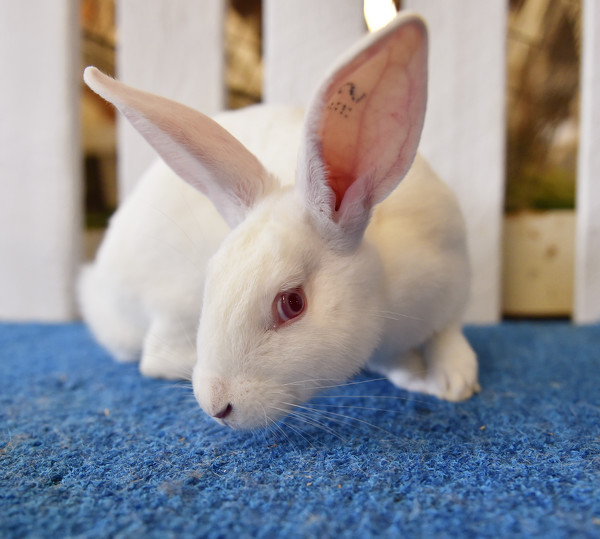Tuesday, August 17th, 2021
4-H members offer barn tours this year
By William Kincaid

Photo by Dan Melograna/The Daily Standard
Buck, Austin Ebbing's New Zealand commercial rabbit, is popular in the rabbit barn at the Mercer County Fair.
CELINA - The 2021 Mercer County Junior Fair King said raising rabbits is a satisfying pursuit and an ideal gateway to fair livestock competitions.
Austin Ebbing, a soon-to-be Coldwater senior who was crowned king, gave a tour of the rabbit barn on Sunday as part of a new event through Mercer County 4-H. Each night, the public gathers at 4:30 p.m. at the back of the junior fair tent to be led on a tour by a 4-H member showcasing animals in a different barn, said Erica Stammen, an assistant educator with Ohio State University Extension.
Ebbing said he decided to raise rabbits some years ago due to having a limited amount of space to care for animals.
"I personally do not live on a farm but I still show rabbits. You really only need a little bit of space and that's one of the reasons that I actually show (rabbits)," he said over the din of fairgoers and squawking fowl. "Rabbits are definitely an easy species if you're just trying to get into the livestock part of 4-H. You can just keep them at your house, and it's definitely a good beginner because you can move onto other species after that."
Not having access to a shed or large-enough garage, Ebbing opted to raise his rabbits outside.
"I keep mine right outside in two hutches with little back spots so if it starts raining they can run in the back," he said.
The Mercer County Fair hosts market rabbits and show rabbits made up of commercial and fancy rabbits, Ebbing said.
"The commercial are much bigger. Fancy rabbits are usually much smaller," he said.
On the market end of the barn, 60 pens contain 120 rabbits.
"It's a lot of rabbits. I'd say it's a little more than average but the rabbit program is doing pretty good with numbers, that's for sure," he said.
Participants typically raise the rabbits for three months before entering them in the fair.
"There's mainly two types of rabbits that we bring in. It's either Californian or New Zealand," he said. "You can tell the difference by the face. The Californians have dark ears and a dark nose and the rest are white."
The New Zealand rabbits, on the other hand, vary widely in appearance, Ebbing said. Some are just plain white with pink eyes.
"They act about the same. They get pretty lazy the older they get," he said. "Right now they're pretty much pigs, too. They love to eat at this stage so you kind of have to watch how big they get."
An ideal market rabbit at show weight is 5 pounds - full and compact yet not "too fat," Ebbing said. Rabbits weighing under 3 pounds or more than 5.5 pounds are disqualified.
A new rule this year allows participants to take their rabbits, except for the grand and reserve champions, home after the fair, Ebbing noted. Some want to use them as breeding stock.
Those not taken home will be sold at market, Ebbing said, noting they typically go for $1 per pound.
Ebbing then turned his attention to the other side of the barn where scores of rabbits, some up to 15 pounds, sat in their cages nibbling on food. Unlike their market counterparts, commercial rabbits live much longer, some up to 10 years or more, he said.
"These rabbits are not usually turned into meat at the end. They are preserved for next year," he said.
He pointed out some of the larger rabbit breeds, such as the American Chinchilla and, one of his favorites, the Flemish Giant.
"That thing's bigger than my dog," he said of the latter.
Another standout for Ebbing is the Mini Rex Rabbit, one of the most prevalent breeds in the show.
"They have super, super soft fur. It's definitely one of the most popular around here, too. They can come in all different colors," he noted.
Though rabbits are one of the easiest animals to raise, there are many ways they can die, Ebbing said.
"You've got to watch how you raise them," he said. "Genetics plays a large role in how you do at the show. So you really got to look at your rabbits before you buy them or breed them."
Ebbing also makes sure to regularly exercise his rabbits to give them a better quality of life, especially the market rabbits that only make it to three months before being sold and turned into meat.
"I know they don't live very long, just try to give them the best life they can (have)," he said.
He also keeps a watchful eye on them. A rabbit's health can change like the flip of a switch, he said. One day they're doing well, a few days later they may be dead. Rabbits are prey animals and don't like to show weakness, Ebbing said.
"Unfortunately, a lot of times when you catch what's wrong with the rabbit it's too late unless it's something like ear mites," he said.

